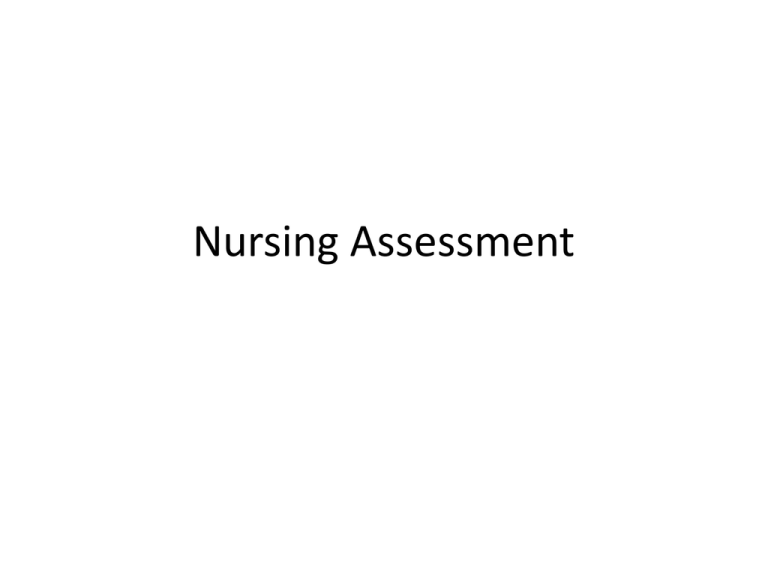
Nursing Assessment
What are we looking for?
• Disease
– -disturbance of a structure or function of the body.
– -signs and symptoms.
– Signs: objective data
– Symptoms: subjective data
– clustered in groups
• Assessment of signs and symptoms
– Assists the physician to make a medical diagnosis
– Assists the nurse in making the nursing diagnosis
Etiology of Disease
hereditary
congenital
inflammatory
degenerative
infectious
deficiency
metabolic
neoplastic
traumatic
environmental
diseases that have no apparent cause (unknown
etiology)
Risk Factors and Development of
Disease
– A “risk factor” is:
• any situation, habit, environmental condition, genetic
predisposition or physiologic condition
• increases the vulnerability of an individual to illness or
accident.
– The presence of risk factors does not necessarily
mean that a person will develop a disease condition,
only that the chances of disease are increased.
Risk Factors and Development of
Disease
– Categories of risk factors
• Genetic & Physiological
• Age
• Environment
• Lifestyle
Nursing Assessment
• Initiating the Nurse-Patient Relationship
–
–
–
–
–
–
–
–
-introduce yourself
-name
-position
-purpose of the interview
-estimate of time
-opportunity for questions and answers
-communicate your trustworthiness/confidentiality.
-convey competence/professionalism.
– Purpose of the assessment:
• -determine the patient’s state of health
• -construct the nursing diagnosis
– Perform assessment as soon after admission as
possible.
• Initial assessment- Nurse and/or MD.
• Ongoing assessment –LPN/RN
• Nurses are often the first to detect changes in the
patient’s condition
The Interview
• -relaxed, unhurried manner.
• -quiet, private, well-lighted
setting.
• -compassion and concern.
• -what name the patient
wishes
to use
• -accepting posture
• -relaxed
• -eye level
• -pleasant facial expression
Biographical Data
– date of birth
– Sex
– address
– family members
– marital status
– religious preference
– occupation
– source of health care
– insurance
Reasons for Seeking Health Care
• Chief Complaint
• - patient’s own words
• OPQRST method:
– O = onset, duration of problem
– P = provocation/palliation: what makes it worse or
better?
– Q= quality/quantity
– R =region/radiation- where it is, where it goes
– S = severity
– T = time: when the problem started, has it been
constant
The Interview
• Past Health History
–
–
–
–
–
–
hospitalizations
allergies
specific reaction to antigen
habits and lifestyle patterns
activity of daily living’ (ADLs)
sleep, exercise, and nutrition
–
–
–
–
Immediate/blood relatives
-health
-cause of death
-history of illness
• Family History
The Interview
• Environmental History
– home environment
• Psychosocial /Cultural History
–
–
–
–
–
–
–
-primary language
-cultural groups
-educational background
-attention span
-developmental stage
-coping skills/family support
-major beliefs, values, and behaviors
Assessment
• Subjective data
• -perceived by the patient
• -Pt. report; states
– Identify symptoms
• nurse unaware of symptoms unless the patient describes the
sensation
• description from the patient
• -onset
• -course
• -character of the problem
• -factors that aggravate/alleviate
Assessment
• Objective data/signs
–
–
–
–
–
-risk for illnesses
-family structure, interaction, and function
-‘barriers’ to care
-seen, heard, measured
-often verified by more than one person
•
•
•
•
-rashes,
-altered vital signs,
-visible drainage/exudate
-Lab results, diagnostic imaging, and other studies
Physical Assessment
• Review of Systems [ROS]
• Systematic method:
–For collecting data on all body systems
–Record in clear and concise manner
–Use appropriate terminology
–Ask specific questions
–Assess the functioning of each system
Head to Toe Assessment
• Items needed:
•
•
•
•
•
•
•
WASH YOUR HANDS!!
-penlight
-stethoscope
-blood pressure cuff
-thermometer
-gloves
-tongue blade
Senses of touch, smell, sight, and hearing.
• Neurologic
– Level of consciousness/orientation
•
•
•
•
•
•
-Awake and Alert?
-oriented to:
-Person (knows his name
-Place (can tell you where he is)
-Time (knows the day and date).
-Purpose (knows why you are examining him)
Head-to-Toe Assessment
• Neurologic cont.
– Assess: Motor Function
• Ask pt. to move each extremity
• Ask pt. to smile, frown, lift eyebrows
– Check Pupilary Response
• Check for size, equality, and shape
Head-to-Toe Assessment
•
Integumentary system
–
–
–
–
–
–
–
–
–
–
–
–
–
–
Observe skin
-color
-scars
-temperature
-lesions
-moisture, texture
-wounds
-turgor
-redness/irritation
-evidence of injury
-color or sclera
-breaks in the skin
-mucous membranes
-tongue
-lips
-nail beds
-palms/soles.
Hair
-quantity
-quality
-distribution
- smoothness
-oily/dry
Scalp should be free of dandruff, lesions, or parasites
• Assessing Skin Turgor
Grasp fold of skin on back of patient’s hand, sternum,
forearm or abdomen.
• -Observe the ease and speed with which skin returns
to place.
Head-to-Toe Assessment
• Strength Testing
If pain or injury begin with normal side
Compare one side to other
Score:
0 = No Active Movement
1 = Muscle contraction, no movement
2 = Full Active ROM with gravity eliminated
3 = Full Active ROM movement against gravity
4 = Full active ROM against partial resistance
5= Full active ROM overcome full resistance
Documentation
Eg. -”Strength in upper extremity was 5/5”
Head-to-Toe Assessment
• Head and neck
– facial expression.
– symmetry of features.
– arteries, veins, and lymph nodes.
• jugular vein distention
– Palpate: -beneath the jaw
-side of the neck
-enlarged lymph nodes
-carotid arteries.
– Auscultate
- carotids for bruits.
Head-to-Toe Assessment
• Nose
–
–
–
–
-symmetrical
-patency
-bleeding/drainage.
-nares.
• Mouth and throat
– -lips/mucous membranes
- use tongue blade and penlight.
– -teeth/gums.
– -breath odor.
• Eyes
– -symmetry.
– -exudate/drainage
– -sclera.
– -pupillary reflex
– -penlight
-PERRLA (Pupils Equal, Round, Reactive to Light and Accomodation)
• Ears
– -symmetry.
– -ear canal.
– -hear/follow commands.
– -hearing aids
Head-to-Toe Assessment
• Breasts
– -examine
– -encourage monthly self-exams
• Spine
– -curvature
-sitting/standing position.
Head-to-Toe Assessment
• Pulmonary System
– Chest
• -bilateral chest expansion.
• -rate/rhythm of respirations.
• -Breathing should be QUIET.
• -posture.
Head-to-Toe Assessment
– Lung sounds
• -breath through mouth quietly
• -more deeply and slower
• -stethoscope firmly but not tightly on the skin
• -listen for one full inspiratory/expiratory cycle
at each point.
• -auscultate using a zig-zag pattern.
• -adventitious breath sounds = crackles,
wheezes
How does Respiration Occur?
Inspiration
Diaphragm
Inspiration
Head-to-Toe Assessment
• Cardio-vascular System
– Heart sounds
• Auscultate
– intensity of the sound
-faint to strong.
-stethoscope
-bell picks up sounds of low frequency
-diaphragm picks up sounds of high
frequency.
-regularity of the rhythm.
Aortic Area -second intercostal space
-right of the sternum
-aortic valve
Pulmonary Area
-second intercostal space
-left of the sternum
-pulmonic valve
Left Lateral Sternal Border (LLSB)
-fourth intercostal space
-left of the sternum
-tricuspid and right heart sounds
Apex(Mitral)
-fifth intercostal space
-mitral and left heart sounds
Areas of
Auscultation
Superior Vena Cava
Aorta
Pulmonary Artery
Anatomical
Heart Position
Patient Positions for Auscultation of
Heart Sounds
Sitting up,
Leaning slightly
forward
Supine
Left Lateral
recumbent
Heart Sounds
Lubb:
-long, low-pitched sound
-closure of the Tricuspid and Bicuspid Valves
-Systolic Murmur
Dupp:
-short, sharper sound
-closing of Pulmonary and Aortic Valves
-Diastolic Murmur
Head-to-Toe Assessment
• Peripheral vascular system
– Peripheral pulses- 8
– Strength on a 0-to-4+ scale
0 = absent
1+ = thready
2+ = weak
3+ = normal
4+ = bounding
– Extremities
– -symmetry
– -color
– -varicosities.
– -temperature of hands and feet.
Capillary Refill
• Time that blood refills empty capillaries
– To “empty” the capillary bed: press a fingernail or tissue
bed until it turns white
– note of the time needed for color to return once the
nail is released
normal capillary refill time is less the (<) 3 seconds
Capillary Refill Time (CRT) is a common measure of
peripheral perfusion.
Palpation of arterial pulses
Radial
. Popliteal
Brachial
Femoral
Dorsalis pedis
Posterior tibial
Head-to-Toe Assessment
• Abdomen
• Check for:
– Shape, lumps, contour,
rashes, lesions, scars
• Auscultate:
– Bowel Sounds in all quadrants
• Listen at least 1 min in each quadrant
• Note hyperactive vs diminished/
absent sounds
• Palpation/Percussion
Palpation of the abdomen ---distention
-masses
- tenderness
Palpation of the liver.
Genitourinary system
Skilled observation:
labia/genitalia
pubic hair.
Palpate
-suprapubic area.
-scrotum
-encourage regular self
examination.
Rectum
assess for hemorrhoids /
lesions.
Legs and Feet
– Palpate
-femoral
-dorsalis pedis
-popliteal
-posterior tibial pulses.
– Range of motion (ROM)
– Color, Motion, Sensation (CMS)
– Temperature
Edema
– Pitting edema
1+ “Trace” -slight pitting
-no visible change in the shape of the extremity
-disappears rapidly
2+ “Mild” -deeper pitting
-no marked change in the shape of the extremity
-disappears (“rebounds”) in 10 to 15 seconds
3+ “Moderate” -noticeably deep pitting
-very edematous and distorted extremity
-last from 15 seconds-1 minute
4+ “Severe” -very deep pitting
-very edematous and distorted extremity
-lasts as long as 2 to 5 minutes
If the edema is not pitting, it cannot be given a grade
Edema of the leg
Edema: It’s not just for legs !
Ending the Assessment
Thank the patient.
Wash your hands
Disinfect pen.
Document your findings thoroughly.
-Documentation does impact the quality of care
given.
Report any significant changes or findings to
the appropriate healthcare professional.
A nurse should perform a quick
assessment of each patient at the
beginning of each shift to determine
actual or potential patient problems
that will require medical or nursing
interventions to promote the safety and
well-being of the patient.
Quick Assessment (A B Cs)
A = Airway
Includes comfort measures
P = Pain
B = Breathing
S = Safety
Water and Call bell in reach
C = Circulation
In = What’s going in
Check IV patency
Infusion rates, machines and tubing
Out = What’s going out
Dressings
Chest tubes
Urinary drainage tubes
http://www.youtube.com/watch?v=9Fxb8icOT
OA










